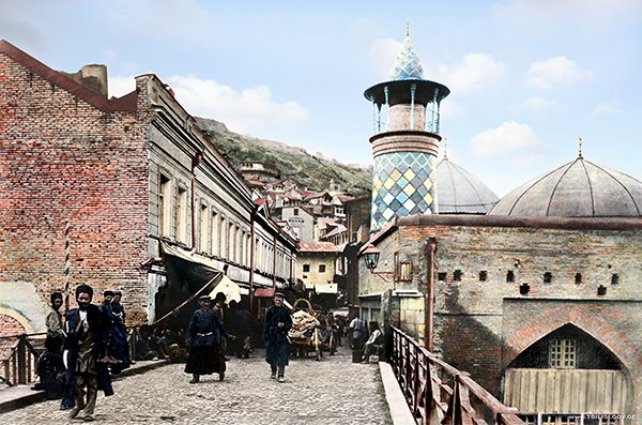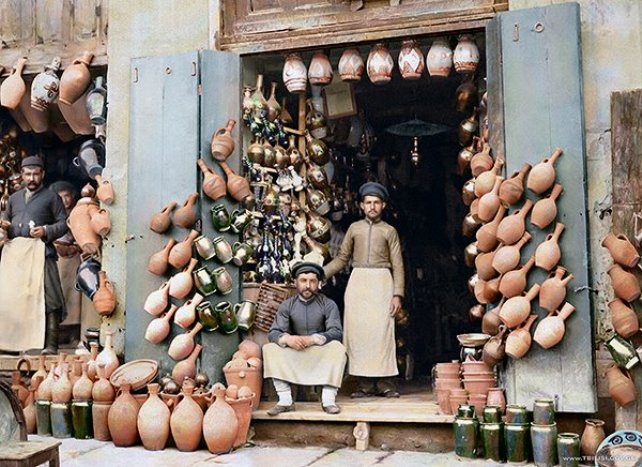Below are two rare hand-colored photographs of the city of Tiflis (Tbilisi) in Georgia in the late 19th century. The photos were taken by the Georgian photographer Dmitri Ivanovich Ermakov. Georgia along with territories in the southern Caucasus had been conquered by imperial Czarist Russia from Qajar-ruled Iran in the early 19th century. The first war between Qajar-ruled Iran and imperial Russia was fought in 1804-1813. This resulted in Iran’s loss of the Caucasus to the Russians, as ratified by the Treaty of Gulistan on September 24, 1813 in the village of Gulistan in the khanate in Nakhchevan. As noted by Kaveh Farrokh in the text “Iran at War 1500-1988“:
“The Gulistan Treaty … was … one of the most humiliating treaties ever signed by Iran throughout her history. Article 3 forced Iran to relinquish all her Caucasian khanates (except Armenia and Nakhchevan) situated between the western shore of the Caspian Sea and Armenia to Russia. These included the khanates of Karabagh (Qarabagh), Ganja, Sheki, Shirvan, Darband, Mughan, Kuba, Baku, and the northern part of Talysh (Including the strategic fortress of Lankoran). These khanates were situated just north of the Araxes River and were not collectively or individually recognized as being part of the Iranian province of Azerbaijan. The historical Azerbaijan was situated strictly to the south of the Araxes River in Iran. In addition to the khanates, Iran was also forced to renounce all of her claims to Georgia (as well as the territories of Mingrelia, Imeretia, and Abkhazia) and Daghestan…The terms of the Gulistan treaty … especially the catastrophic territorial losses in the Caucasus exacted a particularly heavy blow … not just the diminution of the landmass of the Iranian empire… also involved the surrender of a total of 3,000,000 of her citizens (i.e. Persians, Azarbaijanis and Talysh resident in the Caucasus) to Russian rule. “
[Page 194, 2011]
The old bridge-walkway in Tbilisi with the Shiite mosque still evident despite the passage of a number of decades after the imperial Russian conquests (Source: Georgia About).
The second war between Qajar-ruled Iran and imperial Russia was fought in 1826-1828. As noted by Kaveh Farrokh in the text “Iran at War 1500-1988“, this resulted in another defeat for Iran as ratified in:
“… the treaty of Turkmenchai [signed] on February 21, 1828…proved to be even harsher than those of Gulistan in 1813, making it one of the most humiliating Treaties signed by Iran in her history … Article four of the treaty ensured that Iran lost even more territory that she had in the Gulistan treaty. Iran was not only forced to acknowledge her territorial losses as stipulated in the Gulestan treaty, she also had to cede the khanates of Nakhchevan, Yerevan (modern Republic of Armenia), Talysh and other regions such as Mughan and Ordubad to the Russian empire.” [Page 197, 2011]
Colorized photograph of Shopkeepers selling local wine jugs in Tbilisi in the 19th century CE (Source:Georgia About). The style of the shops, their wooden doors and even the display of wares still resembled shops in Iranian territory. Note that this is despite the fact that imperial Russia had been engaged in a decades long anti-Persian cultural campaign in the Caucasus since the late 1820s. These policies continued well into end the Soviet era in 1990.
After the finalization of the Russian conquests of the Caucasus, Tbilisi became the Imperial Tsarist capital of the Caucasus. Tbilisi become the de-facto base of the viceroy of the Tsars of Moscow.





